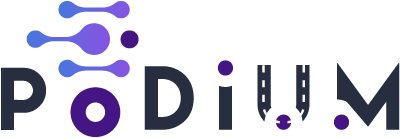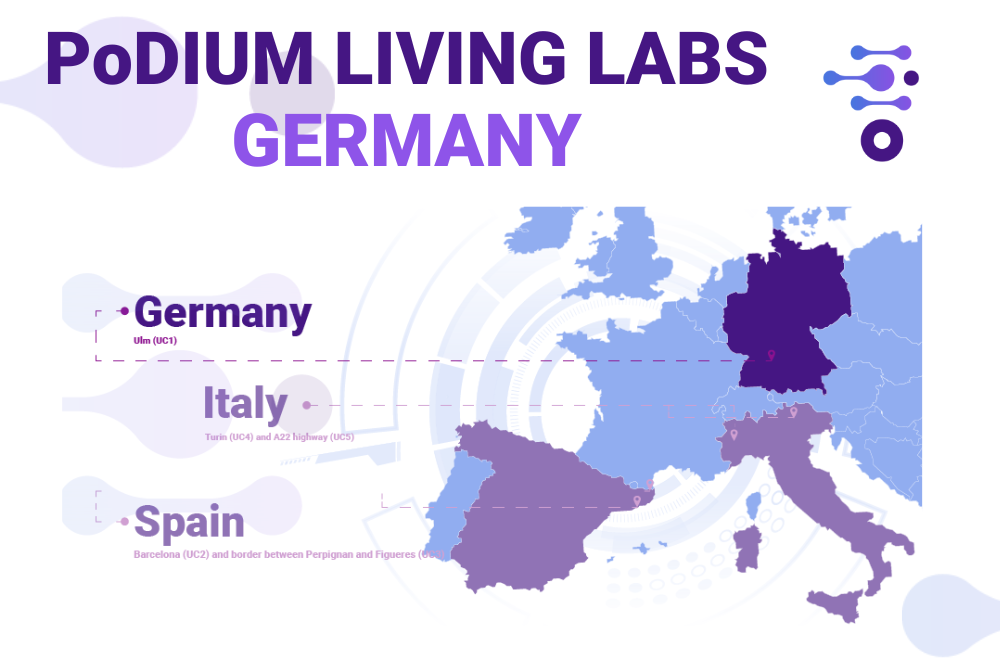PoDIUM aims to advance Connected, Cooperative and Automated Mobility (CCAM) services in Europe by enhancing key Physical and Digital Infrastructure (PDI) technologies. To achieve this ambitious vision, the project has defined five use cases focusing on specific technologies that will be tested and validated in real-life conditions in three Living Labs in Germany, Spain, and Italy to ensure interoperability of these technologies in different contexts. The ‘Inside PoDIUM’s Living Labs’ series will take you on a journey to uncover the specificities of each Living Lab and the use cases they will demonstrate to accelerate the implementation of CCAM in Europe. Let’s explore the German Living Lab!
Ulm-Lehr, a suburban district of the city of Ulm in the German state of Baden-Württemberg, is home to the German Living Lab for the PoDIUM project. The Living Lab is located at the centre of this suburb and comprises two roads, a main and a side road, with one lane in each direction. At a T-junction, the side road merges into the main priority road, which can be very challenging to navigate safely due to occlusion caused by buildings and vegetation. The infrastructure at the junction includes multiple communication technologies, edge computing capabilities and infrastructure sensors mounted to lamp posts.

Navigating complex traffic situations
The use case demonstrated at Ulm-Lehr, ‘Cooperative Corridor Management in the City of Ulm’, will test how a cooperative local traffic management system can help manage complex traffic situations in urban areas. The aim is to improve safety and efficiency in such situations, in line with the EU’s safety and environmental goals. Different communication methods will be set up and evaluated, such as 5G mobile networks with cm- and mm-wave, ITS-G5, and 60GHz WiFi, to ensure that information flows smoothly and improve availability and resilience.
The use case will look at two main scenarios. In the first one, an obstacle, for example a parked truck, blocks one lane. Two CAVs coming from each direction need to synchronise their movements to pass the obstacle safely. This scenario will be assessed with information coming only from the CAV (the lightweight solution), and then with additional information provided by the infrastructure sensors (the baseline solution). Another layer of complexity is added in the second scenario, in which a cyclist connected via a smartphone also needs to pass the obstacle. In this case, the scenario will only be considered with support from the infrastructure.

In essence, the use case in Ulm will demonstrate how CCAM can make the roads safer and more efficient, especially when there are obstacles and a single lane needs to be shared safely. Technical aspects will also be explored further, such as how to ensure reliable and redundant communication, evaluate trustworthiness of data, or determine which communication methods work best. One big question the use case will answer is whether using information from connected vehicles only is enough to ensure a seamless and reliable corridor management.
“If we are successful with the lightweight solution of our use case, this will allow for a much cheaper and earlier deployment of such functions, since no infrastructure sensors would be needed. Furthermore, resilience will be significantly improved by the redundant multi-channel communication.”
PD Dr. Michael Buchholz, Ulm University
Key partners in the German Living Lab
This work can only be achieved as part of the collective effort of highly motivated and skilled experts from the PoDIUM consortium. Ulm University plays a pivotal role as leader of the demonstration in the Living Lab and manager of the Living Lab infrastructure sensor hardware. It is also responsible for the infrastructure environment model (digital twin) and will conduct research on data trustworthiness methods in the Living Lab. In addition, Ulm University operates a prototype CAV that is used in the German use case. Bosch, the technical coordinator of PoDIUM, spearheads the use case in the Living Lab. Bosch supplies infrastructure radar sensors and a prototype CAV, and manages the cooperative manoeuvre planner on the Multi-access Edge Computing (MEC) server. For the communication aspects, Nokia operates the 5G test network and MEC server in the Living Lab. Nokia provides the cellular communication modules and user equipment, as well as the app used by the vulnerable road users to connect with edge services. University Duisburg-Essen takes charge of communication scheduling, taking advantage of redundant communication channels, including 60 GHz WiFi, cellular mobile communication in cmWave and mmWave, and ITS-G5.

